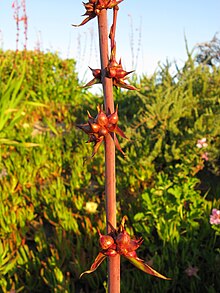Liña xerminal: Diferenzas entre revisións
traducido de en:Germline |
(Sen diferenzas.)
|
Revisión como estaba o 14 de xuño de 2016 ás 18:31
Este artigo está a ser traducido ao galego por un usuario desta Wikipedia; por favor, non o edite. O usuario Miguelferig (conversa · contribucións) realizou a última edición na páxina hai 7 anos. Se o usuario non publica a tradución nun prazo de trinta días, procederase ó seu borrado rápido. |
En bioloxía e xenética, a liña xerminal dun organismo multicelular é a poboación de células corporais que se diferencian ou son segregadas no proceso usual de reprodución e poden pasar o seu material xenético á proxenie.[1] As células da liña xerminal deromínanse células xerminais.[2] Por exemplo, nos animais as células xerminais son os gametos como os espermatozoidee e óvulos e as células das que derivan. Por tanto, son células xerminais os gametocitos (ovocito, espermatocito), que producen os gametos, e as que producen os gametocitos, chamadas gametogonias (espermatogonia, ovogonia).[2] Nos organismos con reprodución sexual, as células que non forman parte da liña xerminal denomínanse células somáticas.


As a rule this passing on happens via a process of sexual reproduction; typically it is a process that includes systematic changes to the genetic material, changes that arise during recombination, meiosis and fertilization or syngamy for example. However, there are many exceptions, including processes and concepts such as various forms of apomixis, autogamy, automixis, cloning, or parthenogenesis.[3][4]
According to this view mutations, recombinations and other genetic changes in the germline may be passed to offspring, but a change in a somatic cell will not be.[5] This need not apply to somatically reproducing organisms, such as some Porifera[6] and many plants. For example, many varieties of citrus,[7] plants in the Rosaceae and some in the Asteraceae, such as Taraxacum produce seeds apomictically when somatic diploid cells displace the ovule or early embryo.[8]
As August Weismann proposed and pointed out, a germline cell is immortal in the sense that it is part of a lineage that has reproduced indefinitely since the beginning of life and, barring accident could continue doing so indefinitely.[9] Somatic cells of most organisms however, can only approach any such capability to a limited extent and under special conditions. It is now known in some detail that this distinction between somatic and germ cells is partly artificial and depends on particular circumstances and internal cellular mechanisms such as telomeres and controls such as the selective application of telomerase in germ cells, stem cells and the like.[10] Weismann however worked long before such mechanisms were known, let alone epigenetic mechanisms or even the genetic role of chromosomes, and he believed that there was some clear qualitative difference between germ cells and somatic cells, though he did realise that the somatic cells differentiated from the germ cells.[9] Many of his views necessarily changed during his life, and some of the resulting inconsistencies were discussed in depth by George Romanes.[11] However Weismann was under no illusions concerning the limitations of his ideas in the absence of hard data concerning the nature of the systems he was speculating on or studying, and he discussed the limitations frankly and analytically.[9]
Not all multicellular organisms differentiate into somatic and germ lines, but in the absence of specialised technical human intervention practically all but the simplest multicellular structures do so. In such organisms somatic cells tend to be practically totipotent, and for over a century sponge cells have been known to reassemble into new sponges after having been separated by forcing them through a sieve.[6]
Germline can refer to a lineage of cells spanning many generations of individuals—for example, the germline that links any living individual to the hypothetical last universal ancestor, from which all plants and animals descend.
Notas
- ↑ Pieter Dirk Nieuwkoop; Lien A. Sutasurya (1979). Primordial Germ Cells in the Chordates: Embryogenesis and Phylogenesis. CUP Archive. ISBN 978-0-521-22303-4.
- ↑ 2,0 2,1 Nikolas Zagris; Anne Marie Duprat; Antony Durston (30 November 1995). Organization of the Early Vertebrate Embryo. Springer. pp. 2–. ISBN 978-0-306-45132-4.
- ↑ Juan J. Tarin; Antonio Cano (14 September 2000). Fertilization in Protozoa and Metazoan Animals: Cellular and Molecular Aspects. Springer. ISBN 978-3-540-67093-3.
- ↑ Andrew Lowe; Stephen Harris; Paul Ashton (1 April 2009). Ecological Genetics: Design, Analysis, and Application. John Wiley & Sons. pp. 108–. ISBN 978-1-4443-1121-1.
- ↑ C.Michael Hogan. 2010. Mutation. ed. E.Monosson and C.J.Cleveland. Encyclopedia of Earth. National Council for Science and the Environment. Washington DC
- ↑ 6,0 6,1 Brusca, Richard C.; Brusca, Gary J. (1990). Invertebrates. Sunderland: Sinauer Associates. ISBN 0878930981.
- ↑ Akira Wakana and Shunpei Uemoto. Adventive Embryogenesis in Citrus (Rutaceae). II. Postfertilization Development. American Journal of Botany Vol. 75, No. 7 (Jul., 1988), pp. 1033-1047 Published by: Botanical Society of America Article Stable URL: http://www.jstor.org/stable/2443771
- ↑ K V Ed Peter (5 February 2009). Basics Of Horticulture. New India Publishing. pp. 9–. ISBN 978-81-89422-55-4.
- ↑ 9,0 9,1 9,2 August Weismann (1892). Essays upon heredity and kindred biological problems. Clarendon press.
- ↑ Watt, F. M. and B. L. M. Hogan. 2000 Out of Eden: Stem Cells and Their Niches Science 287:1427-1430.
- ↑ Romanes, George John. An examination of Weismannism. The Open court publishing company in Chicago 1893 [1]